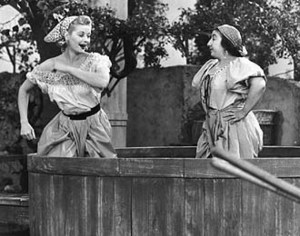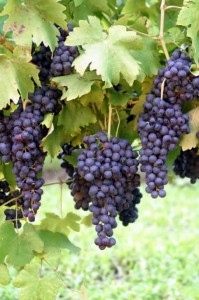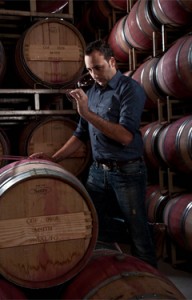 If you’re anywhere near my age, you’ll remember a very funny episode of the “I Love Lucy” show, where, en route to Rome by train, Lucy is spotted by a famous Italian cinema director and chosen to play a part in his new movie “Bitter Grapes.” Lucy sets out to immerse herself in the role. When she nonchalantly wanders into a vineyard inhabited by a motley assortment of Italian-speaking women, she is dispatched to the wine-making area to crush grapes with her feet. [Here’s a link to the episode–Season 5, Episode 23, Lucy’s Italian Movie. The grape stomping scene starts around 19:50 into the episode.]
If you’re anywhere near my age, you’ll remember a very funny episode of the “I Love Lucy” show, where, en route to Rome by train, Lucy is spotted by a famous Italian cinema director and chosen to play a part in his new movie “Bitter Grapes.” Lucy sets out to immerse herself in the role. When she nonchalantly wanders into a vineyard inhabited by a motley assortment of Italian-speaking women, she is dispatched to the wine-making area to crush grapes with her feet. [Here’s a link to the episode–Season 5, Episode 23, Lucy’s Italian Movie. The grape stomping scene starts around 19:50 into the episode.]
 Grape stomping,is part of a method of maceration used in traditional winemaking, wherein the grapes and stems are mashed together, releasing not only the juice from the grapes, but also the phenols and tannins that provide color and acidity. Rather than using a wine press or other mechanized method, grapes were crushed by foot in open vats to release their juices and begin fermentation. The French word pigeage is also often seen in connection with grape stomping, but pigeage, which literally means “punching down the cap,” describes the pushing down of the grape skins that float to the surface of the fermentation vats, forming a “cap.”
Grape stomping,is part of a method of maceration used in traditional winemaking, wherein the grapes and stems are mashed together, releasing not only the juice from the grapes, but also the phenols and tannins that provide color and acidity. Rather than using a wine press or other mechanized method, grapes were crushed by foot in open vats to release their juices and begin fermentation. The French word pigeage is also often seen in connection with grape stomping, but pigeage, which literally means “punching down the cap,” describes the pushing down of the grape skins that float to the surface of the fermentation vats, forming a “cap.”
Grape stomping probably goes back to the very beginnings of winemaking. Historical evidence shows that grapes were stomped at least as far back as Rome in 200 BC. One of the earliest existing visual representations of the practice appears on a Roman sarcophagus which depicts a group of demigods harvesting and stomping grapes at a rural Roman festival.
For centuries grapes were picked by hand and grape stomping was the universal method used to extract juice from the grapes to make wine. In America, most grape stomping by human feet was legislated out of existence by the end of the twentieth century, the concern for public health outweighing tradition. Most other countries eventually banned grape stomping too, but there are still places where you can stomp grapes. If you are really serious about grape stomping, you can compete in the World Championship Grape Stomp at the Sonoma, CA Harvest Fair.
 But there is a lot more involved in making wine than stomping grapes. A vintner starts by deciding which type or types of grapes she wants to grow. She has to consider soil, geology, topography, and climate/microclimate. Praying for good weather–the right blend of warm sun and invigorating rain, the vintner selects the optimal time for harvest, when the sugar level in the grapes is exactly where she wants it to be. The grape crop is then harvested, usually by machine, but sometimes by hand in carefully selected bunches. Then the grapes are rushed from the vineyard to the winery.
But there is a lot more involved in making wine than stomping grapes. A vintner starts by deciding which type or types of grapes she wants to grow. She has to consider soil, geology, topography, and climate/microclimate. Praying for good weather–the right blend of warm sun and invigorating rain, the vintner selects the optimal time for harvest, when the sugar level in the grapes is exactly where she wants it to be. The grape crop is then harvested, usually by machine, but sometimes by hand in carefully selected bunches. Then the grapes are rushed from the vineyard to the winery.
In the winery, the grapes are crushed and the crush is placed in fermentation vats, where the vintner adds yeasts, carefully selected to deliver the desired flavors. During fermentation, which can last from a few days to a few months. the winemaker carefully monitors acidity and alcohol levels, and when she determines that the wine is ready, it is transferred to barrels for storage and aging. Even the barrels are selected with care, since the different woods–French oak, American oak, old oak or new oak–will impart different flavor elements to the final product. Finally after three months to as much as three years of barrel aging, the wine will be bottled and distributed, finding its way to store shelves and wine cellars around the world.
It’s obvious that making wine isn’t easy; making a good wine is hard work and a bit of luck; and a great wine is the result of hard work, luck, and a high degree of both skill and artistry. There’s a huge gap between a grape stomper and a wine maker.
 Unfortunately, we often fail to see the difference. In almost every field of endeavor we encounter people who actually know very little about their real work, but do know how to put on a good show–filled with all the right buzzwords and catch phrases, posing as experts. But unlike true experts, they haven’t put in the time and effort practicing their craft. Unlike true experts, they haven’t learned hard lessons from failed efforts, then come back to try again with improved techniques. Unlike true experts they haven’t mastered their craft in the crucible of experience. They are grape stompers posing as winemakers.
Unfortunately, we often fail to see the difference. In almost every field of endeavor we encounter people who actually know very little about their real work, but do know how to put on a good show–filled with all the right buzzwords and catch phrases, posing as experts. But unlike true experts, they haven’t put in the time and effort practicing their craft. Unlike true experts, they haven’t learned hard lessons from failed efforts, then come back to try again with improved techniques. Unlike true experts they haven’t mastered their craft in the crucible of experience. They are grape stompers posing as winemakers.
Winemakers love their craft; most of them aren’t in the game for the money. [You’ve heard the old joke: “How do you get a million dollars making wine? Start out with five million.”] They study; they experiment; they ask lots of questions. And if they make smart choices and have a bit of luck, they sometimes produce a truly great wine.
It doesn’t “just happen” for winemakers. It won’t just happen for you. Are you willing to work for it? Do you want to be a wine maker, or will you settle for being a grape stomper?
Being crushed for better wine is a prerequisite for wisdom and luck a necessity for success
Lucy’s Grape Stomping episode was always a favorite of mine. Ironically, while Lucy might have been a grape stomper in that story, she was truly a skilled wine maker as one of the great comedic actresses of our time.